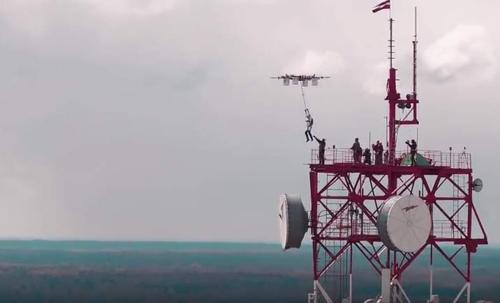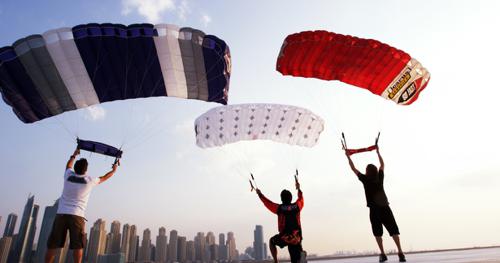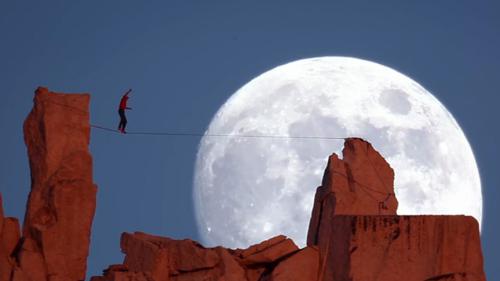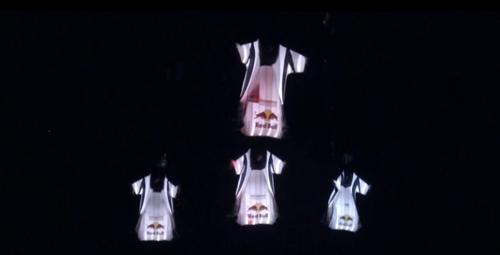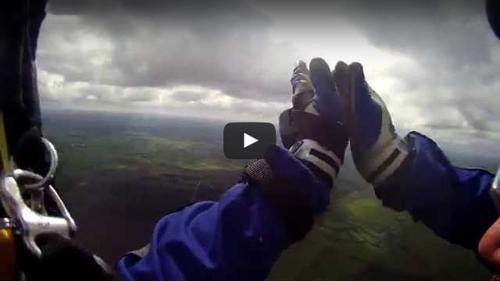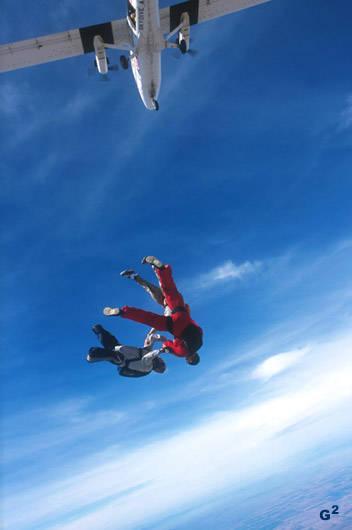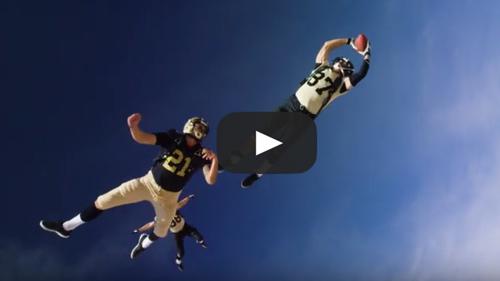Receiving an AFF Instructor rating is one of the pinnacle points of a skydiver’s continuing education and experience in the sport skydiving world, and has been a personal goal of mine for approximately two years. I was sure that the moment I had six hours of freefall time and my C license, I'd be able to knock this thing out fast.
How wrong I was...
This badge is likely the most expensive badge in the
skydiving world
When I first began skydiving, I was presented with the opportunity to spend some time in the tunnel at Perris, CA, with Ed Dickenson and Jay Stokes. I immediately took Ed up on his very generous offer to help me in my progression towards being a camera flyer. At 27 jumps, I entered the tunnel to learn some of the techniques I’d later use to fly with tandems, four-way, and fun jumpers. The video is hilarious.While I waited for Ed, we hung out at the school in Perris, and I overheard many conversations taking place between students and instructors. It was at that point I decided to become an instructor. Jay Stokes, Ed Dickenson, and Jack Guthrie all encouraged me to look towards that goal, yet six hours of freefall and a C license seemed so far away at that point, it quickly fell off the radar. I was having a hard time waiting for my 200th jump just so I could put on a camera anyway, let alone being an instructor.When I hit 200 jumps, I immediately got my coach rating. Alright! I was prepared to be unleashed on unsuspecting just-off-AFF-students.My first coach jump went great and filled me with a confidence that I had never before experienced. My third coach jump didn’t go so well with me finding myself very low, opening at an altitude that got me grounded for the weekend. Little lessons seemed to constantly present themselves. Although most of my wingsuit coach jumps have gone well, I once took a student with only 160 jumps. Bad decision; he had a cutaway (on a rig he'd borrowed from me) and I'm grateful that's all that occurred. I grounded myself for the weekend, and learned that lesson the hard way.It seems like most of us have stories like that; this one was my moment of enlightenment.
Over the next two years opportunity to teach, be taught, sit in on teaching experiences, and grow within the sport continually presented themselves. Like many skydivers, I surely thought I “had it all” in the 500 jump range when in truth, I was merely beginning to understand how much more there was to learn. As one skydiver repeated over and over (and over), “You don’t know what you don’t know.” Well…he’s right. I was discovering how little I knew, how far I had to go, and I was finding myself on the road of discovery.Being part of the qualification process for the 71 Way Wingsuit World Record opened my eyes to what good wingsuit instruction could be. I gained information over the last year that is integral to the first flight process as well, taking instruction from Scott Campos, Scott Callantine, Sean Horton, Justin Shorb, Jeff Nebelkopf, Scotty Burns, and several other very experienced wingsuit coaches. Like most skydivers, I've experienced great coaching and not-so-great coaching in my skydiving progression.
Being present when a friend was part of a tragic incident at the start of the year convinced me that I needed to know more about instruction, and I began looking at available AFF course opportunities. At the PIA conference, USPA President Jay Stokes informed me that Certification Unlimited (Jay’s instructional entity) was putting up a Coach and AFF course at Skydive Arizona in the following weeks. Timing was going to be tough, as I had some minor surgery scheduled, but I was excited to take advantage of the closeness of the opportunity, at one of my favorite dropzones, and in warm weather while it was freezing back home.
Image Left to Right:
Alex Chrouch, Jay Stokes, Craig Girard, Kelly Wolf, Nikos, Eliana Rodrigues, Douglas Spotted Eagle
Arriving in Eloy on a Saturday, I was completely pumped to start my education then and there. After all, I have 1300 jumps, 19 hours of freefall time in a couple of years, so this was going to be a fun cakewalk, right? I mean, I’ve got more than three times the requisite hours, lots of experience teaching, how hard could it really be? I’d taught parts of many First Jump Courses, taught many wingsuit students, and sat in on several courses. I knew I was ready.
How incorrect my thought process would prove to be.
Jay began with the syllabus and schedule for the course. It was daunting, but still appeared to be not insurmountable.
We did a bit of class work that night but the real class began in earnest Sunday morning at 8:00 a.m. with the dew wet on the grass, sunrise barely behind us, and no coffee in sight, Jay smacked the class between the eyes with a number of videos that showed why the AFF program is so important, why the training would be very precise, and why each jump would be rated with “Satisfactory/Unsatisfactory” with no grey areas. “I’d bust my own mother if she wasn’t doing it right” is something we’d occasionally hear. And I believe it, but wasn’t intimidated by the concept. In fact, the only thing that had me intimidated was learning that repeat World Champions Craig Girard and Eliana Rodriguez were in my class. It’s somewhat difficult for a Hyundai to shine when parked between two Ferrari’s, right?
I knew I’d nail this stuff in a heartbeat. The written test was a cakewalk, just missing one question. And that question used math.
To say “I suck at math” would be akin to suggesting that “Omar is an OK skydiver.”I use a calculator for two plus two. True story. The ground training process is specific, but I’m used to this stuff, it’s pretty basic if you have the program down (thanks TDog, for providing some good pointers).Passing the written test indeed was a cakewalk compared to what came next... the in-air practicals.
Game-on, kids….We were assured the first jump would be our one opportunity to experience a “good student practice jump” where the student would behave and do essentially everything instructed, exactly as instructed.True to his word, Jay jumped like a perfect student. I was on the main side, Alex on reserve side.The jump went well from the Otter; no exit problems, the student responded perfectly to my signals, even if I was a little amped and anxious on this first jump. I thought Alex and I were a solid team. Suffice it to say that Alex did an outstanding job of flying his slot, keeping eye contact with his partner (me) and of doing his part in keeping our “student” corralled.Next jump, Jay paired me and a different partner with Kelly, a newly-minted AFF Instructor Evaluator.She went out the door with legs both bent forward at unique angles, arms in every direction but straight forward, and the only guarantee we had was that she wouldn’t roll onto her back during this practice jump.
Manhandling her into a level position without punching her required a great deal of strength. My partner lost his grip, floated up, and next thing I knew, I was alone with my student. I wasn’t going to let her go, except I was required to. And did so.She flew away, turning like a propeller just starting up and gathering speed as she backslid, turned, and orbited. I knew I had fewer than 15 seconds to catch her (which sounds like an eternity, but in truth, it’s the blink of an eye for the second jump as an AFFI Candidate). I caught up and had her blocked in a few short moments, but those same moments seemed like an eternity in themselves. She grinned and decided to go the other way. I think what troubled me wasn’t that the grin was mischievious; it was evil, clearly payback for what she had been subjected to as an AFF candidate. Cruel, cold, calculated evil. But we were having fun, right? My partner was floaty, at least 20’ up and 20’ out from where our student was spinning, but he did eventually make it most of the way back in. I ended up on the reserve side after her spins and subsequent blocks, and so the dance at the bottom was a little different; it was my first experience with dancing on the left. I pulled the handle, deploying my student and she looked at me with a grin that made the previous evil smile appear to be innocent; I’d failed to ride through the actual deployment. The triumph I’d felt at properly feeling the rhythm and cadence of the dance evaporated like palm sweat in a 120 mph wind.
Moving on before I exaggerate more than I already am….let’s look at the third jump of the afternoon.
It was beautiful. Stunning. The sort of sun and sky that Eloy is famous for, and it was about to be spoiled. This time, I had no partner and no one on whom to place blame for the carnage that was about to occur. Combat Wingsuiting, combat RW could not have prepared me for a single, main side exit in which my student extended arms straight forward, legs nearly as much so, almost as if she’d been laid over top of a fence to dry, face down. I muscled her so that she remained belly to earth and she obviously didn’t like that action very much. She immediately pretzeled her legs with the right leg looking like it was flying over a hurdle in a heat, and the other leg bent 45 degrees forward and bent again at the knee. It was like she was performing a classic freestyle position but on her belly instead of her toes pointing straight down. Arms were practically folded above her head, and it was all I could do to force an arch. Duh…throw a hand signal and there might not be quite so much force necessary….
Thumb down, she arched like a pro. “Today’s skydive is brought to you by the letter ‘U’” as she arched so hard that she plummeted. Thank heaven I hadn’t asked her to wear the lead. I don’t like lead much, and my fall rate range is pretty broad. All those tandems and AFF videos have helped.
OK, she’s settled out. Calm, flying great, she gets a thumbs up and a terror-laced grin from her instructor. I give her signals to do a practice pull and toe taps. She does great and so therefore has earned a release. I released and she backslid from the moment I let go of her harness. Damn, that girl is fast, but so am I. I chased her with a side-slide, threw her a legs-out signal. Wow….look at her move forward! Faster than she was going backwards. Now, I’m orbiting and don’t even realize it until I’m looking at her butt in my windshield. So…forward I go, and out goes the hand signal for arch; I was behind her. She didn’t have a rear-view mirror so my only option was to slide sideways, slide my left hand under the BOC as I started to slide past, and toss her another “arch” symbol. Whew! She settled out….Mr Toad couldn’t have had more of his way with me than Kelly did on that skydive.
And that was just the first day….
Variations on the theme make for a colorful tale; the ground experiences as we prepped to get into the aircraft were equally interesting but it would spoil the movie if I share too many of the instructor’s tricks as they acted the part of wayward students. Suffice it to say that they’re there to help you succeed, but also there to allow you to fail if you’re not on your toes and looking out for the best interests of the student at all times. The dives aren’t about you, they’re about being sure your student is getting the appropriate attentions and instruction at all times.
I won’t bore you with further details of the skydives because they’re all about the same sort of story; carnage, deceit, evil appropriations of an examiner that demands you be able to drive forward in a sideslide while dropping like a stone to do an assisted rollover as they’re spinning with a maniacal grin, laughing at the poor sap chasing them. It’s like “Hare and Hound” with Dr. Dimento as the wily rabbit, always one step ahead. Just as you catch up, they cooperate. In the moment you breathe a sigh of relief, they’re on to the next trick. Carly Simon going through my head with “Anticipation…”
Lest you think I exaggerate too much, grab any AFF instructor who has had Jay’s program or anyone who Jay has taught. They’ll tell you I’m not kidding and if truth be told, I’m underselling the experience.
Lemme share a small story; If you deploy your instructor/student “for real” by pulling their hackey, it’s an automatic Unsatisfactory and regardless of whether you did everything previous right or not, you weren’t successful on this skydive due to that one fairly significant factor. “Students” wear a simulated hackey that AFF candidates are required to pull at a specific point in the skydive. AFF Candidates will hold the simulated hackey handle til they meet up with the instructor on the ground.Jay didn’t care for the fact that I kept stuffing the hackey handle down my pants when it came time for my own deployment. On my last skydive, we’re standing in the door of the aircraft and my ‘student’ is going through “check out” and in his up/down/arch mode when I realize there is no simulated hackey visible on his main-side lateral.I’m screwed. I absolutely must deploy my student at the bottom of the skydive. I must pull the simulated hackey and show the instructor that I pulled and that I rode through the deployment. That small handle is the proof in the putting that I did exactly as I was trained to do.
In other words, those handles are important.
What to do, what to do?
Worry hammered me throughout this skydive, my last in the series of eval dives. With a “Satisfactory” I’ll be able to catch my flight scheduled to leave Sky Harbor in about two hours. If I get an “Unsatisfactory,” I’m not going home and believe me, the price for that would be very high. I have commitments outside of skydiving, y’know?
The point of do or die is one that lasts for about three seconds or 500 feet. I make my decision and dammit, I’m sticking to it. Maybe.
I reach for my student’s leg gripper, look at my altimeter and begin the process. I’m counting down. By now, the “dance” is so freakin’ ingrained in my head that I’m doing it in my sleep, so much so that I’m convinced I did it perfectly on this skydive even though video shows I didn’t.
Reaching over to where the simulated hackey was supposed to be, I spied it turned behind the lateral.
Gave it a yank at the last possible moment, and proudly raised the simulated hackey as I ducked my head beneath his deployment hand (the last thing you want to experience is a bridle wrapping around your neck, or having the deploying hand knock you in the side of the head; it might be construed as interfering with the student).
And rode out his deployment. The last thing I remember seeing as my instructor lifted above my head was his look of wide eyes, pointed finger, open mouth, and the smile on his face. We got to the ground, I watched my student land, and debriefed the skydive.Mirth in my instructor’s eyes, he says “Nice job. Now tell me what you didn't like about that skydive."A grin crossed his face told me he was well aware of the location of the simulated hackey. And, I knew I’d passed the program at that point.A wave of relief passed over me and I felt like falling to my knees and crying myself dehydrated, but I doubt any moisture would have come forward. I’d forgotten to rehydrate in my excitement of this last day. I was drained. I was pwn’d. I was reduced to jelly and tissue in this last moment. No way, no how would I have signed up for this experience had I really known what was in store for me, of this I was sure. All week.
But…
At the end of the week’s worth of mental, physical, and emotional torture, after hearing Lou Gossett in my subconscious screaming “I WANT YOUR D.O.R.!!!,” I’m a better skydiver. I’m a better person, and I’m a more informed instructor. I now know a little more about what I don’t know. As I said before, I'm now firmly on the road to discovery. "SATISFACTORY" or "UNSATISFACTORY", anyone who endures the process will come out a better person on the other side of the hellfire. I promise.
I now have a new respect for those that have undergone this process before me. I understand why they are looked to with a unique sense of appreciation at every dropzone, I understand that the program is as much or more about teaching the next step in the educational process of qualified skydivers as it is about providing a license to teach the uninitiated. The AFF rating is a license to teach but it’s more a license to learn. In roughly 18 skydives, I learned a lot about what students can and will do. I learned how to best manage those situations with my new found abilities, and learned that if in 18 controlled scenarios I could learn this much, how much can I learn in a year, two years, five years of teaching a variety of students? I’m excited at the prospect.
Respect and appreciation is due where it’s due, and I’ll take the opportunity to point out that as skydivers, we all have foundations made up of the bricks of those around us. Jack Guthrie, Jay Stokes, Ed Dickenson, Norman Kent, Mike McGowan, Debbie Z, Lance B, Kelly W, Joey, Chris, Phil, Blake, Craig, Eliana, Alex (I’ll jump with you any day, kid), Nikos, Jeff, Justin, Scotty, Scott, Chuck, friends on dropzone.com…and so many others are the bricks that have helped pave the road on which I have driven as a skydiver seeking more knowledge. I don’t know how to thank you all for the inspiration beyond paying it forward and being the best instructor I can be as you have been great instructors in my life. OK, enough lovefest. Thank you.
It's the little things that make the difference on a skydive whether for the better or worse. Taking instructon from Norman Kent's camera course that taught me to anticipate movement, taking instruction from Ed in the tunnel that helped me develop a very high range of fall rate for a heavy person, and being part of numerous FJC and FFC courses helped me develop a comfortable ground patter and rhythm. All the pre-AFF prep you can do, I recommend you take the time to do it. You'll be glad you did.
Whether you went through AFF, Static Line, IAD, take a moment to thank your instructors; they worked hard to get to where they are, to be at a point where they can intelligently and safely teach others, including yourself. It’s a big, dangerous world out there and instructors walked just a few feet ahead of you, checking to make sure it’s the best environment within which we all learn. Buy em’ a beer, give em a smile, even if it’s been a long time passed by.
Receiving my rating from Jay Stokes, Certification Unlimited (and current President/USPA)
In the event you’re wondering by now, students are a little less safe; I squeezed through my AFFI course. It’s an expensive patch and logbook endorsement, but one I urge towards anyone with an inkling to teach.
I wouldn’t trade the experience for the world.
Blue skies and puffies....
~dse

